
02161115044

Underwater arc discharge is one of the most effective water treatment methods because of the effects of intense shockwaves and high ultraviolet radiations. In this thesis, a high-voltage underwater arc discharge system is proposed to study the inactivation of Escherichia coli bacteria, which has an arc-robust feature. It consists of a high-voltage capacitor charger and a discharge circuit. This thesis includes three goals as described below.
First, the high-voltage capacitor charger is developed by a novel LCCL resonant converter. Generally, the performance of the resonant converter is highly affected by the parasitic elements of the high voltage/high power transformer. Also, short circuit condition is a frequent event in high voltage and arc discharge applications, so that the resonant converter should be robust against the short circuit condition and unwanted arc occurrence. This thesis presents a novel LCCL resonant converter with current source scheme used as a high voltage capacitor charger. The proposed resonant converter eliminates the undesirable effect of the stray capacitance in high voltage devices and is robust against the short circuit condition inherently. Furthermore, a frequency-sweep control method is applied, which has advantages in reducing the resonant current’s peak value and the resonant network’s size. Simulation results show a satisfactory performance of the proposed resonant converter. Moreover, experimental results confirm the effectiveness of the proposed resonant converter in the application of capacitor charging.
Secondly, the discharge circuit is developed by a two-step spark gap scheme using an ultrafast high-voltage trigger circuit. It prevents unwanted arc discharges during the charging. Also, it provides a system operation independent of the water conductivity.
Thirdly, the proposed underwater arc discharge system has been applied to 500ml of pollutant water to study the system’s performance on the inactivation of E. Coli bacteria. The proper microbiological tests have been carried out, showing the effectiveness of the proposed underwater arc discharge system. The complete inactivation of E. Coli bacteria is achieved in an extremely short treatment time. The proposed system inactivates the bacteria completely with 13.2J/ml energy consumption and 0.04Sec./ml treatment time. Also, a 4.5 log reduction of the bacteria is achieved with 7J/ml energy efficiency. The treatment time is 20 seconds, and the solution conductivity is 14.5mS/cm. Moreover, the experimental results are presented, which validate the desired performance of the proposed underwater arc discharge system.

Power Electronics and Energy Systems Laboratory was established in 2010 with the aim of training efficient engineers and researchers. In this educational and research environment, specialized fields such as the design of power electronic systems, including all types of power supplies, inverters and rectifiers, high and multi-level power converters, types of high voltage or HV systems, energy conversion systems, etc. are under study and research.

Design: Mahyan
Leave a Reply